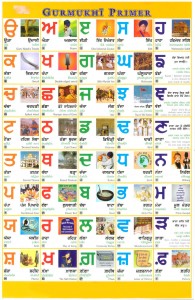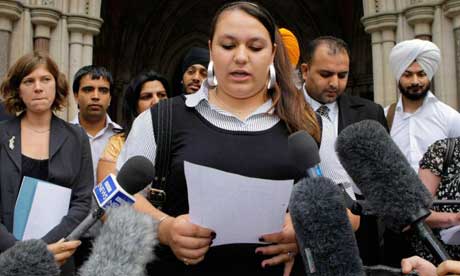
In light of the recent post on Punjabi classes in California high schools, I ran into this article in the Chronicle Herald about Sikh summer school:
A couple of years ago Aman Tut’s seven-year-old daughter asked her if she could wear a Christian cross. Tut was surprised because she and her husband are Sikhs… So they enrolled their girls in summer school at the Golden Triangle Sikh Association temple near Petersburg, just west of Kitchener.
The Tut family works weekends and isn’t able to attend the weekly Sunday services and school programs at their gurdwara. The local gurdwaras have come up with a really interesting model to augment their typical “Sunday school” courses.
Four years ago, organizers started a weekday program that runs from 4 p.m. to about 9 p.m. each day. Unlike most vacation Bible school programs that run for a week or two at many churches, kids attend the Sikh program from early July to the end of August… At the beginning of each class, about a dozen students take music lessons on instruments that are used during Sikh worship services. The boys learn to beat rhythms on tabla drums, and girls are taught the basics of the harmonium, an instrument resembling both a tabletop organ and an accordion. By 5 p.m. the majority of students have arrived for classes in Punjabi language, Sikh history and religion.
I don’t know if, as an adult, I would be able to make it to a class every day, but I really liked how the organization had set up their summer school classes, and I wonder if it could be extended or expanded into a “night classes” model for adults during the rest of the year, as well. It seems like a really helpful and interesting alternative to Sikh youth camps, which are often too short or lack enough context to help kids build long-term knowledge and skills. It also has the added benefit of being close to parents who may be concerned about sending their kids away but still want them to benefit from a religious education. What do you think, readers? Between high school programs and night courses, what model of instruction (and time commitment) would work for you, individually, and possibly for your child?
Is the tipping point (the level at which the momentum for change becomes unstoppable) approaching for a change in attitudes towards the value of women and need to have sons?
There has been a widespread, public movement condemning sex-selection by the government, ngos, and others in the community for some time now (this hard-hitting song by Sarabjit Cheema is a must-see). Since Amartya Sen’s articulation of ‘missing women,’ the rights of women in developing countries have been at the forefront of international agendas. In a recent development, Sunita Rao, an Indian pop singer, has released a song condemning sex-selective abortion and become the spokesperson for the LAADLI campaign, funded by the United Nations Population Fund.
Suneeta Rao’s latest album WAQT’s press conference was held in Hotel Palace Heights, New Delhi. It was on behalf of United Nations Population Fund (UNFPA). The singer is the official spokesperson of the Laadli campaign of UNFPA that focuses on the pleasure and pride of having a daughter and motivates people to fight injustice against the girl child. ‘The video of the first song in my album ‘Sun Zara’ is a dedication to all girls, Suneeta said, UNFPA has gratefully supported in making the video of this album. According to United Nations Population Fund, “This video has been made for the Girl Child, to address the issue of Sex Selection and to help stop female feticide”. [link]
The song mentioned above, Sun Zara:
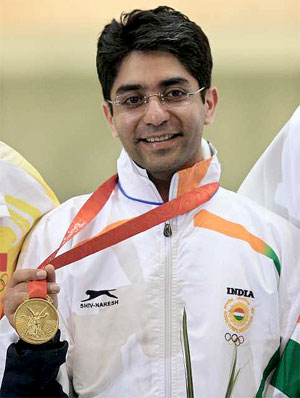 Today Abhinav Bindra won the first individual gold medal ever claimed by any Indian Olympian. He competed in and won the 10M air rifle event this morning in Beijing. We originally posted about him a few days ago here.
Today Abhinav Bindra won the first individual gold medal ever claimed by any Indian Olympian. He competed in and won the 10M air rifle event this morning in Beijing. We originally posted about him a few days ago here.
Abhivan hails from Chandigarh, Punjab and is the son of Dr. A.S. Bindra and Babli Bindra. Abhivan has been training since childhood as a shooter and is a holder of the Khel Ratan Award, India’s highest athletic honor. This is his second time at the Olympics.
His family had gathered at the Sector 8 Gurdwara in the three days preceding his competition for an Akhand patth sahib thanking Waheguru for his success and praying for a win. After hearing that his son had won the gold, Dr. A.S. Bindra proclaimed:
My son has proved that ‘Singh is King’ in a real sense. He has brought laurels for the whole Sikh community and for the whole nation…
——-
As an aside – for those of you wondering, as I was, what his name means – it means “quite new”
Also just found a link to Abhinav’s personal blog
Harwant Kaur is from Punjab and will be competing in the discus throw. It seems that she has recently moved to Australia after a career in the Punjab Police with only dismal prospects. She had previously finished 13th at the Athens Olympics in 2004.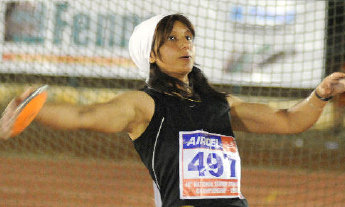
The women’s discus qualifying round is set to begin on Day 7 (Friday, August 15, 2008)
Mandeep Kaur seems to be from Punjab. She is competing in the Women’s 400m race as well as in the women’s 4×400m relay. I could not find a picture or any other information.
The 400m race qualifying rounds begin on Day 8 (Saturday, August 16, 2008) and the 4x400m relay will begin on Day 14 (Friday, August 22, 2008)
Langa(w)riters have posted in the past on issues surrounding the preservation of the Panjabi language here, here, and here. Be it anywhere from Panjab to North America, the preservation of the Panjabi language is intimately tied to the preservation of a Panjabi and Sikh heritage. For example, in a recent article on Live Oaks High School offering Panjabi courses, Mohinder Singh Ghag, director of Live Oaks Schools Foundation stated:
“The language is the only reason we have a link to our ancestors.”
Thus, the discussion around solutions has understandably centered around learning Panjabi in homes, gurdwaras, high schools and universities. I personally think having these learning opportunities available at all these different sites is a much-needed step towards maintaining the Panjabi language. I have always found the process of getting Panjabi classes taught in high schools particularly interesting because of how they require engaging the community, the reasons for creating them, and how they are incorporated into the public K-12 educational system.
For example, commendably in Live Oaks, California (located about 10 miles north of Yuba City, California):
Punjabi community members knocked on doors and made announcements in temples to get teenagers to sign a petition expressing interest in a Punjabi language class at Live Oak High School.
About 25 students signed-up.
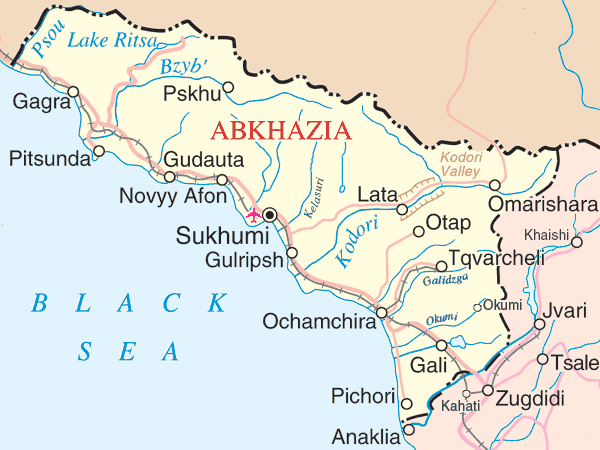
Like many, my family and I watched the opening ceremonies of the Olympics last night. In the middle of the parade of nations, the commentators off-handedly remarked that the country of Georgia had just been invaded by Russia, over an escalated territorial dispute (note that this region of the former-USSR has been the stage for other battles over nation and territory; the Chechen Republic is a close neighbor of Georgia on its northern border). Russia has launched a full military campaign involving air and ground troops and targeting the Georgian city of Gori (not located in the disputed region); this has already resulted in civilian injuries and deaths. Georgia has also asked for U.S. assistance in airlifting their troops from Iraq back home.
I can’t confess to know the entire back story; I’m terribly unfamiliar with Abkhazia and had no idea that hostilities had been mounting (beyond the “normal” level) between Georgia and Russia. In reading the NYT coverage this morning, I stumbled across this statement:
Georgian officials said their only way out of the conflict was for the United States to step in, but with American military intervention unlikely, they were hoping for the West to exert diplomatic pressure to stop the Russian attacks.
As familiar as I am with realpolitik, I was alarmed that the only “hope” for stabilization or a stop to the assault was U.S. intervention. This made me reflect on the concept of witness: in times of war, what does it mean to bear witness to an atrocity, but fail to intervene? In times of “peace,” what does it mean to acknowledge that human rights abuses take place, but fail to challenge a system that prioritizes compliance? What does our faith require in these moments? In these moments, what is justice, and what is our duty as a faith community that values justice and freedom?
Updated and extended, August 9
I try not to do this too often, but I realized I may not have adequately contextualized what I was getting at when posting on Hard Kaur. I’ve tried to extend the analysis and conversation below:
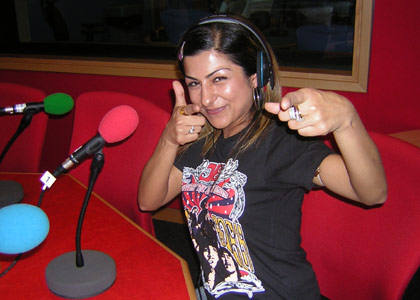
I’ve been thinking about Hard Kaur (Taran Kaur Dhillon) a lot lately, primarily because I’ve been flirting with the idea of buying her debut album, Supawoman. Hard Kaur is a tricky personality for me. On one hand, girlfriend has overcome the adversity of her hard knock life as a pioneer in her field. On the other hand, her conflation of Sikh and Punjabi identity, her often unimpressive rapping, and her totally not-Sikhi-friendly lyrics make me reconsider her as a role model. Is she an emblem for Sikh women’s empowerment, or perhaps just a symbol for women of color artists? Her moniker and image are dramatically at odds with one another. So what do we embrace, or eschew, from her, and can we negotiate how this works for young Sikh women?
Many point to HK’s intense image and claim that she is not a Sikh role-model, and others would claim she’s not a particularly good role model for other young women, either. I agree with the former and disagree with the latter (more after the jump).
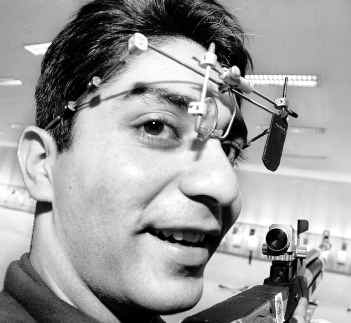 Abhinav Bindra was considered a child prodigy, but has had limited success on the largest competitive stages. Still he is considered a medal hopeful.
Abhinav Bindra was considered a child prodigy, but has had limited success on the largest competitive stages. Still he is considered a medal hopeful.
Bindra will be competing in the 10m air rifle competition. Qualifications and the finale will all be on Day 3 (Monday, August 11, 2008) in the afternoon
In these commentary posts, I will be republishing my original writings as well as include pictures of the athletes and the timings of their events.
There will be four Canadian field hockey athletes that come from Punjabi Sikh backgrounds on this year’s Canadian Olympics Team. Our Sikh community’s fearless foursome will all be wearing turbans (pagris) during the Opening Day Ceremonies.
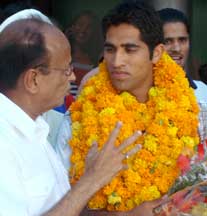 Rowing
Rowing
Manjeet Singh, a Chandigarh rower, has had much success at the junior levels. He will be competing in at the world stage in Beijing in the lightweight double sculls event. While Manjeet Singh and his partner Devinder Kumar are not considered medal contenders, they are hoping for a top-10 finish.
Rowing is set to begin on Day 1 (Saturday, August 9, 2008) at 17:00-17:10.
Representing the world of weightlifting, 5’3” Jasveer Singh (sometimes written Jasvir Singh), who came from Punjab in 2002, has become a Canadian and Sikh sensation (many communities have even held akhand 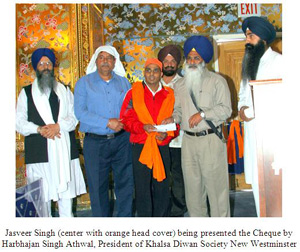 paaths to raise money for him). He is the first British Columbian weightlifter to go to the Olympics in twenty years. Jasveer (Jasvir) Singh has been sponsored by many Sikh groups including the Khalsa Diwan Society New Westminster in hopes of bringing Olympic glory to Canada. On the right you can see Jasveer Singh being honored and given a check by members of the Westminster Sangat.
paaths to raise money for him). He is the first British Columbian weightlifter to go to the Olympics in twenty years. Jasveer (Jasvir) Singh has been sponsored by many Sikh groups including the Khalsa Diwan Society New Westminster in hopes of bringing Olympic glory to Canada. On the right you can see Jasveer Singh being honored and given a check by members of the Westminster Sangat.
Jasveer Singh will be competing in the Men’s 62kg category. According to the official Beijing 2008 Olympics schedule, the event and the medaling ceremony will all be on Day 3 of the Olympics (Monday August 11, 2008).
So today will mark the opening of the Olympic Games. Some will cheer for their states; some will cheer for their heroes; some won’t care.
Well, here are FOURTEEN reasons to care: reasons that transcends national barriers and in many ways is more reflective of our Sikh-centered, globalized outlook. It is related to the fact that Sikhs from throughout the world congregate here at The Langar Hall and that issues ranging from Kenya, New Zealand, Canada, Panjab, England etc. all interest us
So in this spirit of continuing to foster a globalized Sikh diasporic community, I present to you the untold story of Punjabi Sikhs in the Olympics. The reason I am using the term ‘Punjabi Sikh’ is because I don’t really know how they identify themselves, but their names indicate that they come from a common ethnic stock – a Punjabi Sikh background.
I am trying to make this list comprehensive, so if I left anyone out, please feel free to post a comment and I will go back to add them. Let’s make this a project we do together, by posting their finishings and results. [also thank you to Mandeep Singh for correcting some of my mistakes]
Sikhs in the Olympics:
Sikhs are one of those great unknown Olympic stories. It is a diasporic story where Sikhs have representeed many countries and many continents. In the Beijing Olympics, there will be Sikhs (on as far as I could figure out using the wikipedia lists) coming from India and Canada. In years past, Sikhs have been included on teams from Kenya, Great Britain, and even Malaysia. From the regions of the five Olympic Rings (Blue – Europe, Yellow – Asia, Black – Africa, Green – Oceania, Red – Americas), Sikhs, including those in the diaspora have been at the center of many Gold medal winning teams – especially in field hockey. As far as individual glory, Milkha Singh “the Flying Sikh” disappointing fourth place finish in the Men’s 400M in the 1960 Rome Olympics.
Jathedar of the Akal Takht, Giani Joginder Singh Vedanti, resigned yesterday without providing any real reason for the step down. From reports it seems that the Jathedar was asked to resigned late Monday night 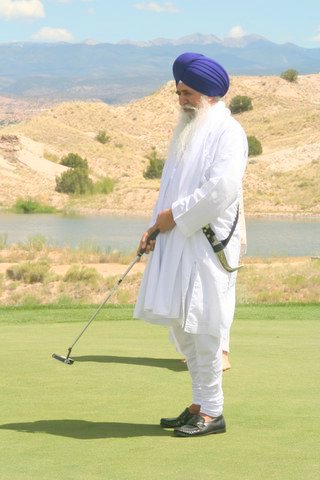 after some SGPC execs visited him at home – the apparent reason: differences of opinion with the Shromini Akali Dal (lead by Badal) and the SGPC (lead by Makkar). In an attempt to cover up the transparently obvious removal, the SGPC president, Avtar Singh Makkar attributed the resignation to Vedanti’s ill health. However, most sources reported something more along these lines:
after some SGPC execs visited him at home – the apparent reason: differences of opinion with the Shromini Akali Dal (lead by Badal) and the SGPC (lead by Makkar). In an attempt to cover up the transparently obvious removal, the SGPC president, Avtar Singh Makkar attributed the resignation to Vedanti’s ill health. However, most sources reported something more along these lines:
It is understood that Vedanti’s increasing proximity with hard liner Sikh organizations on the issue of Dera Sacha Sauda and his public opinion to vote for Sikh Prime Minister Dr. Manmohan Singh during UPA government’s trust vote on July 22 last were key factors that compelled SGPC to pack up Vedanti. The reports said that Punjab Chief Minister Parkash Singh Badal had told Vedanti to quit else he will be expelled.
After reading about Jathedar Vedanti removal and the circumstances, (like many others) I am a bit confused and disturbed with the recent trend – Jathedar Vedanti’s removal is not a first:
The removal of Bhai Jasbir Singh Rode as the Akal Takht Jathedar started the trend of sacking Jathedars. Previously, a Jathedar either resigned or died in office.
Bhai Ranjit Singh, the daring Jathedar of Akal Takht was sacked on April 28,1998 and SGPC installed Giani Puran Singh as the new Jathedar on February 15,1999. Vedanti was appointed as acting Jathedar of Akal Takht on March 28, 2000 after the SGPC then led by Bibi Jagir Kaur blamed Giani Puran Singh of violating the maryada (Sikh code of conduct) and sacked him.
I think what makes this most unsettling is the fact that the Jathedar of the Akal Takht is supposed to be given a certain degree of credibility and authority. The Jathedar is a Sikh leader; someone who represents our interests, is our ambassador, and serves as a guide to Sikhs worldwide. I’m not giving him/her Papal status by any means, but the Jathedar’s position is an executive role within the Panth and removal at the whim and fancy of often corrupt officials in the SGPC or the SAD illegitimates any credibility the position once held. The fact that the last four Jathedars have been “removed” by the SGPC/SAD & Co. says a great deal about the way our Panth is run…little of which can be construed in a positive light.
In a recent post, Camille asked important questions around growing Sikh female leadership/representation, rather than just “managing” it. At the heart of leadership in any organization is decision-making. A critical component of growing Sikh female-leadership/representation is giving access to decision-making spaces that are commonly occupied by Sikh men and incorporating female perspectives into decision-making. Thus, you will see the strongest battles for gender equity in Sikh organizations tend to be fought around decision-making power. A recent example of such a battle was at a Gurdwara in Bristol, U.K. where two factions were fighting over allowing women to take part in Gurdwara elections. Women were demanding the right to vote while also running for committee-member seats. This past Sunday during Gurdwara management-committee elections, both factions broke out into a riot over allowing 79 women to vote past the registration deadline.
According to the Daily Mail:
Six riot vans were dispatched to close the road in Fishponds, Bristol, and one man was arrested and cautioned for a public order offence during the seven-hour stand-off.
Voting finally finished at 4pm and resulted in three women being voted onto the management committee for the first time in the temple’s history.
The trigger for the riot was when one man frustrated by the situation started trouble inside the Gurdwara that spilled out onto the street where “women were blocking his car and trying to push it over while he was still inside clinging to the steering wheel”.
An elderly women at the site reported “… a crowd of mainly women and children stood on one side of the road and men on the other. They were fronting each other up and shouting abuse across the road. The women were screaming ‘we’re not going anywhere’.
In case you’ve missed the front page of every major newspaper in the past few days, nearly 150 people died in a stampede in the Naina Devi temple in Himachal Pradesh. (As great of a tragedy as this is, I’m not sure why it’s front page on American newspapers, considering that incidents of this nature occur all too often in India.)
Religious pilgrims were trampled to death on a hillside on Sunday morning, after rumors of a
landslide sparked a stampede, local officials said. Thousands of Hindu pilgrims traveled to Naina Devi, a hilltop temple in the state of Himachal Pradesh, on Sunday during a festival celebrating the Hindu mother goddess. Heavy rains in the morning led many to take cover in a shelter, local officials said. Some eyewitnesses said visitors on their way down the hill claimed large stones began sliding down the hillside, leading to panic in the crowd below, while others heard rumors of a bomb. [link]
In addition to the stampede, deaths were caused by lack of required medical care.
Local clinics were overwhelmed by the injuries and ran short of medicines and supplies. [link]
During this time of tragedy, the Sikh community came together through kar sewa to assist with the bodies when the government failed to arrange transportation for the bodies. Kar sewaks also organized and served langar and cha to the grieving relatives of the deceased who were camping at the evacuation site.
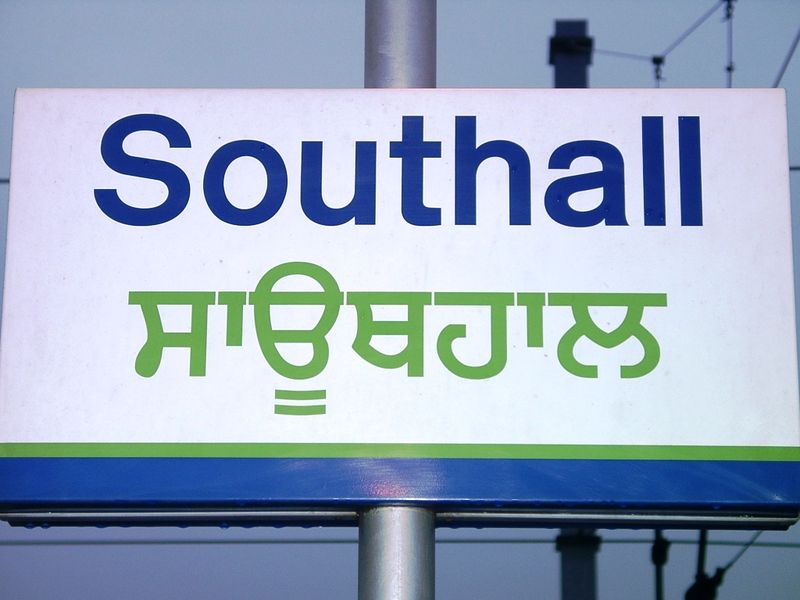 I was in London last week and stopped off in Hounslow, Ealing and Southall to just walk about and visit family. In the past 50 years, Southall has become a huge pass-through and historic cultural and political center for Punjabis, especially Indian and Sikh Punjabis, in London and the greater UK. I visited the neighborhood a few years ago, and I looked forward to returning.
I was in London last week and stopped off in Hounslow, Ealing and Southall to just walk about and visit family. In the past 50 years, Southall has become a huge pass-through and historic cultural and political center for Punjabis, especially Indian and Sikh Punjabis, in London and the greater UK. I visited the neighborhood a few years ago, and I looked forward to returning.
I was a little surprised to see that the neighborhood had changed. In addition to taking on an ever-growing refugee population from Somalia, there seemed to be a growing Sikh Punjabi underclass. Southall, historically, has been populated by working- and middle-class desis, and with that comes a variety of concerns around resource availability, support, language and social services, etc. Multi-family or multi-worker flats and apartments are not uncommon, but I was surprised by the increased concentration of subpar worker housing. Instead of the more prevalent norm of helping out new immigrants by sheltering them and helping them acclimate to London, there seemed to be a small (but growing) formation of Punjabi-run slum housing, similar to the exploitative workers’ ghettoes and communities of New York in the early- to mid-1900s.
I was really distressed by this development; Southall has amazing local institutions that are nationally and internationally reknowned for their civic engagement and dedication. In many ways, it is the face of the UK Sikh community, for better or worse. I’m not naive; I know that our community has deep and complicated internal issues and challenges. How do we begin to address these basic issues of justice, their connection to Sikhi, and what this means for the reputation and behavior of the community as a body? I don’t think we should dictate or micro-manage people’s behavior, but I do think it’s important to have begin to create ways to mediate conversations and norms/attitudes around how Sikh ethics translate into practice.
I recently ran across Relocating Gender in Sikh History by Doris R. Jakobsh who is now an Assistant Professor of Religion at the University of Waterloo. I’m not a scholar of either Sikh history (and Jakobsh shouldn’t be considered one until she can read and understand Gurbani), and the ideas presented below are just fodder for discussion – not being put forth as any authoritative data.
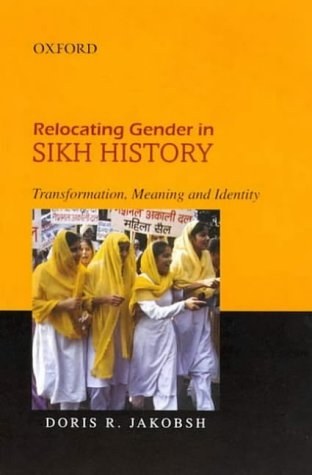 The framework she uses notes the difference between the prescribed Sikh belief of equality amongst Sikh women and men, and what is actually practiced within the Sikh community, claiming that gender has generally been dealt with in 1 of 4 ways: silence, negation, accommodation, idealization.
The framework she uses notes the difference between the prescribed Sikh belief of equality amongst Sikh women and men, and what is actually practiced within the Sikh community, claiming that gender has generally been dealt with in 1 of 4 ways: silence, negation, accommodation, idealization.
One of the biggest problems that I noted when reading the book is her use of English translations of Gurbani for her basis of analysis. We’ve discussed before the problems that we, as Sikh practitioners, experience in understanding Gurbani, due to language barriers. Yet, she bases her research on translations that are subject to the same barriers and misunderstandings. Because of this language barrier, her reading of Gurbani is way off. Despite this, I do believe her feminist analysis of historical writing warrants discussion.
1- Silence: Jakobsh claims that silence is the guiding principle regarding women in Sikh history. Traditional recording of history focuses on politics and economics, realms that women have not been well represented. Women have also not been the authors of their own history, and so the specific questions asked have been those of interest to male historians.
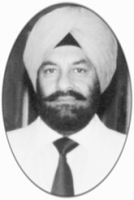 Although a semi-frequent traveler to Canada, I must admit I have never been to the city of Vernon. I have been to the city Mt. Vernon in Ohio. Not a pretty place.
Although a semi-frequent traveler to Canada, I must admit I have never been to the city of Vernon. I have been to the city Mt. Vernon in Ohio. Not a pretty place.
Well in a week that saw the tragic death of Ishmeet Singh and the triumphant victory of Sarika Singh in the UK, I found a personal obituary of note through Google News.
It seems this past week, the Sikh community saw the passing of a “Good Citizen That Made A Difference,” Satwant Singh Dhindsa. His popularity and his commitment to service are expressed in the article.
Ishmeet Singh’s shocking and tragic death this week will be felt for some time. During his tragically short life and time in the public eye, he was as a role model and inspiration for many. He will truly be missed.

Sarika Watkins-Singh won her case in South Wales this week. The news was in many newspapers, including The Guardian, which is normally well researched. Considering the high standard of journalism that its reporters are normally held to, it’s surprising that the following statement was made so off-handedly, in a story about Sarika’s case.
Mr Justice Stephen Silber concluded the school was guilty of indirect discrimination under race relations – Sikhs are a race – and equality laws. [link]
Um, we are?! Last I heard, Sikhi was a religion. How does a religion become a race? Where did this author get this idea from?
The only remotely related idea that this statement could come from stems from the antiquated idea that Sikhs are a martial race. But even wikipedia makes clear that this idea is no longer acceptable.
Martial Race or Martial Races Theory is an ideology based on the assumption that certain ethnic groups are inherently more martially inclined than others. It was a term originally used by the British, who observed that the Scottish Highlanders were more fierce in battle than others in the British Isles, and extended this concept to India, where they classified each ethnic group into one of two categories: ‘Martial’ and ‘Non-Martial’. A ‘martial race’ was typically considered brave and well-built for fighting but was also described as ‘unintelligent’. The ‘non-martial races’ were those whom the British believed to be unfit for battle because of their sedentary lifestyles. Of late, this concept has been dismissed as Imperialistic and based on racial stereotypes. [link]
